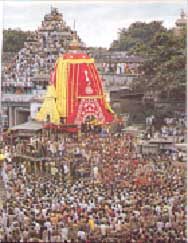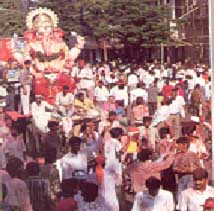RATHA YATRA
On the second day of the bright half of Ashadha(June- July), Ratha Yatra is celebrated throughout the country, and chariot processions of Sri Jagannath are taken out through the main streets in many cities, but the main festival is held at Puri in Odisha.
This is famous throughout the world and many foreigners also participate in this spectacular event. The 12th century Jagannath shrine is situated on the Nilchala Mountains, 60 kms from Bhubaneshwar. It is one of the four great holy places of the Hindus. The other three being, Badrinath, Dwaraka and Rameshwaram.
It is believed that a three days and nights sojourn to Puri will free a pilgrim from future births and deaths. On this day, the idol of Lord Jagannath is taken on an enormous chariot, which is 45 feet high, and 35 feet square and has sixteen wheels, which are seven feet in diameter.

The legend of Lord Jagannath is quite interesting. A hunter killed Krishna accidentally and some pious people found his body and stored the bones. Later Vishnu directed a King called Indrayumna to make an image of Jagannath and place Krishna's bones inside it. Vishwakarma was assigned this job and he asked for privacy till the work was complete. But the King impatiently went to the architect and so Vishwakarma left the images undone. That is why the deities have no hands and feet.
The king of Puri, the descendant of king Anantavarman Chodaganga, and the original founder alone has the right to carry the Lord's umbrella and other paraphernalia. Over 6000 males are at the Lord's service, headed by the king. Some 20,000 people are said to be dependant on the temple for their livelihood.
TEEJ
Teej, purely a festival of girls and ladies is sacred to the Goddess Parvati, the consort of Lord Shiva. It was on this auspicious day that Parvati was reunited with Lord Shiva after a long separation. It is annually celebrated in most parts on India, and especially in the state of Rajasthan, on the third day of the bright fortnight of the month of Shrawan. Processions bearing the images of Parvathi are taken out escorted by caparisoned elephants, camels and horses.
On the occasion of Teej, young girls of the house who dress up in sarees, lehangas and Chunris perform Dandia dances. Basically Teej is a festival of Rajasthan and Gujarat. On the day of Teej, it is a must for the girls to receive clothes from their parents. Newly married girls get special costly attires from their parents.
Swings are hung on trees and in the houses and the women amuse themselves. Fairs are also arranged on this occasion and people enjoy themselves. This festival seems to welcome the coming monsoon season.
RAKSHA BANDHAN
Sravani, the sacred thread tying ceremony, and Raksha Bandhan are celebrated on the full moon day of the month of Shravan (July- august). Sravani is a specifically Brahmin festival, referred in the ancient Sanskrit scripts and it is regarded as an important day in Bengal, Odisha, Gujarat and some Southern states.
The origin of Raksha Bandhan has a legend behind. Once there was a fierce battle between the Gods and the demons and the Demons were about to triumph. The next day was the full moon night of the month of shravan. Indrani, the wife of Lord Indra, prepared a chasm according to the rules prescribed in the sacred texts and tied it on her husband's wrist. And it happened that when Indra entered the war-front with the chasm in his wrist, the demons lost and fled away. Probably, Raksha Bandhan appeared from this belief.
Now, it has come to be a sitter's day, symbolizing the love that binds them to their bothers. Once a girl ties a "rakhi", as the sacred thread is called, in any man's wrist, he becomes closer to the girl than other blood relations. During this season, all stops are found stacked with colorful and glittering wristlets of all hues and colors and to fit every pocket, with values from a rupee to a few thousand rupees. On the day, the girls and boys dress in their best and girls take the rakhi to their brothers and daub his forehead with vermilion and saffron and then tie the rakhi. They also give sweetmeats to their brothers. The boy in return gives some money to his sister as a mark of affection. When a girl ties a rakhi on her brother's wrist, she makes fervent wishes for her prosperity, happiness and success in all he undertakes. In return, the guy renews his pledge to guard her honor and self-respect. In some places Raksha Bandhan is also called Rakhi, Rakhri and Saluno.
There are several mentions about this Raksha Bandhan in our history. Maharani Karmvathi's kingdom was once besieged by Governor Bahadur shah. She did not know what to do and so she sent a rakhi to the emperor humayun who immediately accepted it and came to fight with Bahadur shah, and routed his army, despite he being a Muslim ruler and the Maharani being a Hindu. Rajasthan has many tales from history regarding this Rakhi tying custom. During the freedom movement, many women tied rachis on men's wrist and made them pledge their lives for the liberation of India. The great leader of Bengal, surendranath banerjee, even tried to elevate this Raksha Bandhan to the status of a national festival.
GANESH CHATHURTHI

On this pious day viewing of the moon is strictly prohibited. On the Ganesh chathurthi day, all women who are desirous of the welfare of their husbands and sons compulsorily worship him. This is a special function day and the grandest festival of the state of Maharastra. Almost each locality of every town has its own image of Ganesh, specially made for this occasion. Though there are many places where the idols are made, the images made from a village called "Pen" are rated higher in Maharastra.
The size of the Ganpathi idols varies from a few inches height to over a hundred feet. How long the idol is kept a t home depends on family tradition. It may be thirty-six hours in some houses and it may go unto five, six or seven days till Anant Chaturdashi. Children decorate the idols with colorful strings and papers and Arthi is performed daily. It is customary to make offerings of twenty-one blades of grass, Kewra(Pandanus buds), a lotus flower and twenty-one modaks as "Prasadam.
The local community Ganesh images appear bigger in size and it is depicted in a variety of activities. New forms are invented to depict the current theme and fashion. It was Lokmanya Bal Gangadhar Tilak who made the ritual worship of Ganesh in Maharastra almost a national festival. The festival is fondly called "Ganesh-Utsav".
JANMASHTHAMI
On the eighth day of the black half of bhadra(August-September) was born shri Krishna, the eight avatar or incarnation of Vishnu. Therefore this day is known as Janmashtami or Krishna Janmashtami. This auspicious day of the birth of Krishna, the direct manifestation of Lord Vishnu himself is celebrated with great éclat and enthusiasm all over the country.
Sri Krishna was born as the eighth son in a prison cell to Devaki and Vasudeva. Fearing for the life of his son, Vasudeva flew to Gokula and exchanged him for a baby girl born to Nanda and Yashoda there. The janmashtami celebrations start from the early morning bath in the sacred waters with prayers. The climax is the midnight with the rising moon, which marks the divine birth of Lord Krishna. On this day the devotees observe strict fast until midnight. Temples and homes are decorated with scenes of Krishna's birth and his childhood pranks. At night after the birth, the child image of Krihna is given a bath in Charnamrita.
In Braja Mandala, especially in gokula and Mathura, this festival is celebrated with greatest fervor and enthusiasm. People from all over the country congregate at Mathura and Vrindavana for this special occasion. The fast observed on this day ensures the birth of many good sons and salvation after death. The Bhagavad Gita and the Geet Govindam are read on this day at houses and in the temples.
ONAM
Onam is a festival of flowers, a spring festival. It falls on Shravan day in the month of Shravan or Bhadon (August-September). During this period the harvest are over and the farmers will be in a festive mood with their granaries full. Onam has a legend attached to it. In ancient times, an Asura King Mahabali ruled Kerala. He extended his rules to the heavens and the nether world. So, the King of gods, Indra hatched a plot to oust him. Disguise as a Brahmin boy, Vamana, he asked Mahabali to give him as much land he could cover in three steps. As the King agreed, Vamana grew in size till he was big as the Universe. He took two steps and covered the earth and the heavens in the two steps and asked for the King's head for his third step. Then vamana pushed Mahabali into the far below nether land. But before that, the King sought Vishnu's permission for visiting the earth once in a year, and it was granted.
The celebration of Onam is tribute to Mahabali's sacrifice. In memory of the happy days of Mahabali's rule, a grateful Kerala celebrates his annual homecoming with all pomp and grandeur. Onam celebrations last for ten days, beginning with a colorful reception to King Mahabali. Earthen mounds, which like square pyramids, representing Mahabali and Vishnu are placed in dung-plastered courtyards and decorated with beautiful flowers. After the traditional prayers, the people of the house are given new clothes. A lavish feast as to what one's purse can afford follows this.
Certain dances like Kaikottikali take place. The most exciting of all is the Aranmula Boat Race. Men, women and children come from far and near to watch these snake-shaped boat races.
Interestingly during Onam, not only King Mahabali but also Vishnu is also worshipped. The celebration of Onam became very popular after the establishment of a temple dedicated to Vamana at Thrikakara nears Cochin. The temple was built in the 8th century. Hindus, Muslims and Christians of Kerala symbolizing the hopes and aspirations of all of the Keralites now celebrate Onam.

